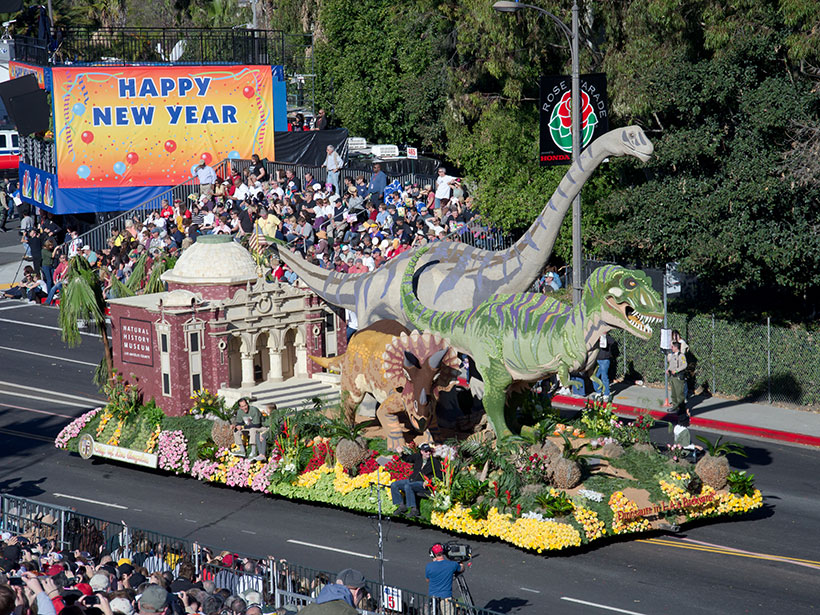The 2020 Tournament of Roses Parade was watched by 700,000 spectators as it wound its way through the streets of Pasadena, Calif., and was broadcast live to another 7 million people.
A few scientists were also eavesdropping on the pavement-pounding event using a new type of seismic array. The technique could inspire a few new parade prize categories—such as heaviest float, loudest band, and most coordinated marching—as well as revolutionize seismic monitoring in both urban and offshore settings.
[pullquote float=”left”]“The Rose Parade is a well-controlled event. This provided a rare opportunity to calibrate the new seismic network.”[/pullquote]The Pasadena distributed acoustic sensing (DAS) array was installed by researchers at the California Institute of Technology (Caltech) in November 2019 by converting two strands of unused telecommunications fiber-optic cable into a citywide seismic instrument. “The primary goal of the Pasadena Array is to detect small earthquakes, but we have not yet had any good-sized earthquakes in the city to test the system,” said Zhongwen Zhan, a seismologist at Caltech in Pasadena and an author of the new study, published in Seismological Research Letters.
“The Rose Parade is a well-controlled event,” Zhan said, with no other traffic except the parade, which travels in a uniform direction at almost constant speed. “This provided a rare opportunity to calibrate the new seismic network.”
Everyone Loves a Parade

Zhan and colleagues drew upon data collected by a stretch of fiber-optic cable that supports around 400 seismic sensors. The 2.5-kilometer cable runs directly beneath the parade route. “The data turned out to be even better than we thought,” Zhan said, capturing both short- and long-period vibrations with “remarkable” resolution down to a few meters.
The seismic record shows the zigzag patterns of police motorcycles used to clear the route; the long and steady vibrations as the road flexes under massively heavy parade floats; and the coordinated, harmonic steps of marching bands. A distinctive gap appears when the Mrs. Meyer’s Clean Day float got stuck at a tight turn and backed up parade traffic for 6 minutes.
The prize for the heaviest float went to Amazon Studios, which had a real bus and rocket mounted on a truck.
https://twitter.com/TroopZeroMovie/status/1212418890694705152
The loudest marching band was the Human Jukebox from Southern University and A&M College.
https://twitter.com/HBCUBuzz/status/1212582341195051008
“This is a really fun paper because it’s easy to connect with the subject matter—most people have been to a parade and can imagine how the floats and bands and people could produce seismic noise,” said Nathan Lindsey, a geophysicist at Stanford University who was not involved in the new study. “It’s also a great demonstration of what DAS can do in the urban realm.”

The Next-Generation Seismic Network
DAS systems work by sending laser pulses along fiber-optic cable and measuring the photons as they return back to a sensor at one end of the cable. When the buried cables are flexed by ground motion from an earthquake (or a heavy parade float), researchers can examine changes in the size, frequency, and phase of the reflected pulses to determine the nature of the passing wave.
With existing fiber-optic cables ubiquitous in many cities, “these DAS systems are very easy to set up,” Zhan said. “You basically plug the instrument into one end [of the cable], and you’re ready to go.”
Pasadena’s DAS system, run by Caltech, is connected to 37 kilometers of fiber-optic cables, which support over 5,000 seismic sensors. A few other places have deployed similar networks, though Pasadena’s is currently the largest citywide system in operation, Zhan said. DAS systems are also proving useful offshore and in other settings where deploying and maintaining traditional seismic instruments are logistically challenging, Lindsey said.
“The number of applications for DAS technology is quite impressive,” he said. “Not only for earthquake science, but also for studying volcanoes, the cryosphere, hydrology, geomorphology, and geotechnology in both the built and natural environments, onshore and offshore. This new tool is really flexible, and fiber is everywhere.”
Currently, the technology is limited mainly by “how much data one research group can analyze,” Lindsey said. “These systems generate terabytes of data per day, which adds up to a massive amount of data very quickly.”
—Mary Caperton Morton (@theblondecoyote), Science Writer
Citation:
Morton, M. C. (2020), Everything’s coming up roses for Pasadena seismologists, Eos, 101, https://doi.org/10.1029/2020EO145149. Published on 04 June 2020.
Text © 2020. The authors. CC BY-NC-ND 3.0
Except where otherwise noted, images are subject to copyright. Any reuse without express permission from the copyright owner is prohibited.

